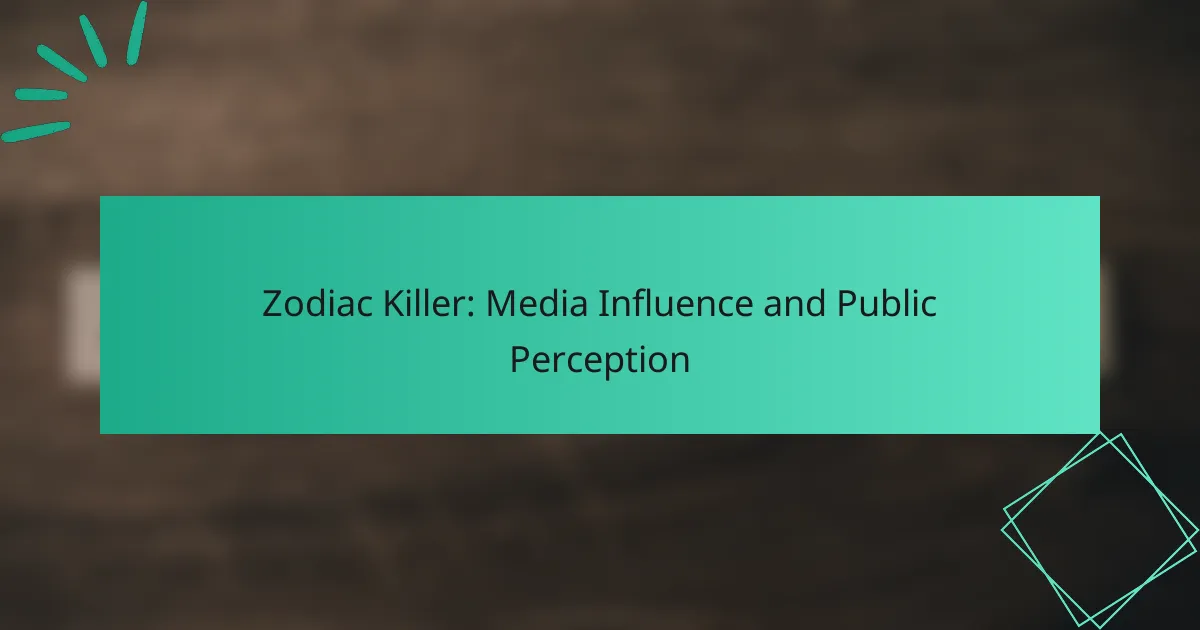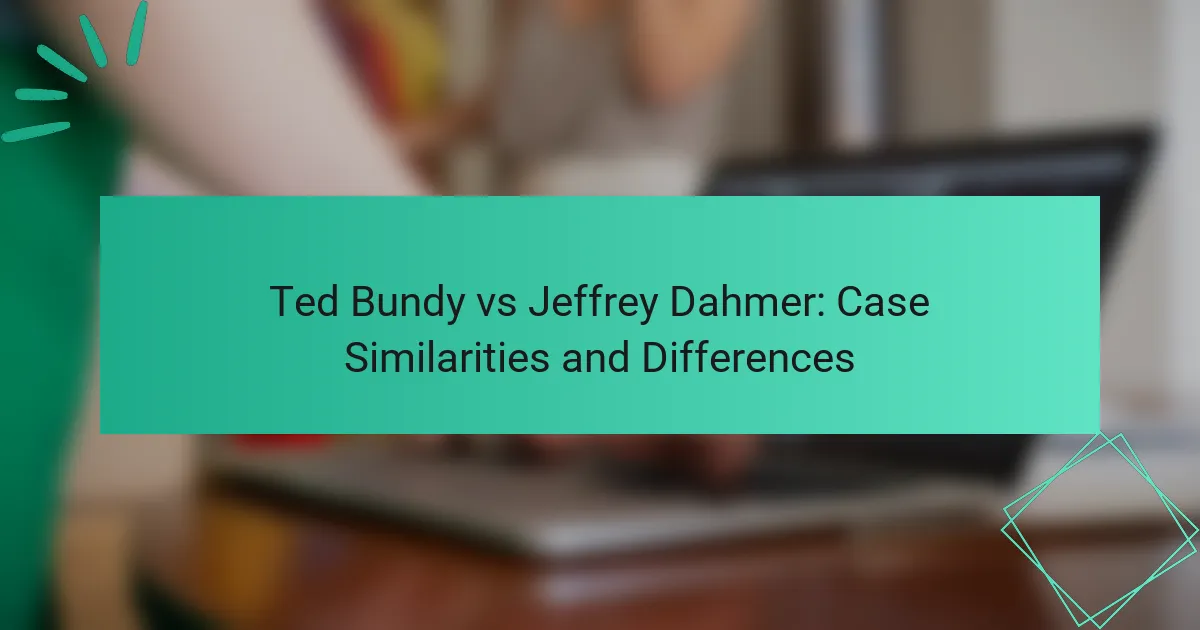The Zodiac Killer has profoundly influenced media representations of serial killers, leaving a lasting mark on public fascination and fear. This impact is reflected in numerous documentaries, crime dramas, and sensationalized news coverage that shape the narrative surrounding the unsolved case. Today, the public perceives the Zodiac Killer through a lens of intrigue and horror, captivated by the mystery of his identity and motives.
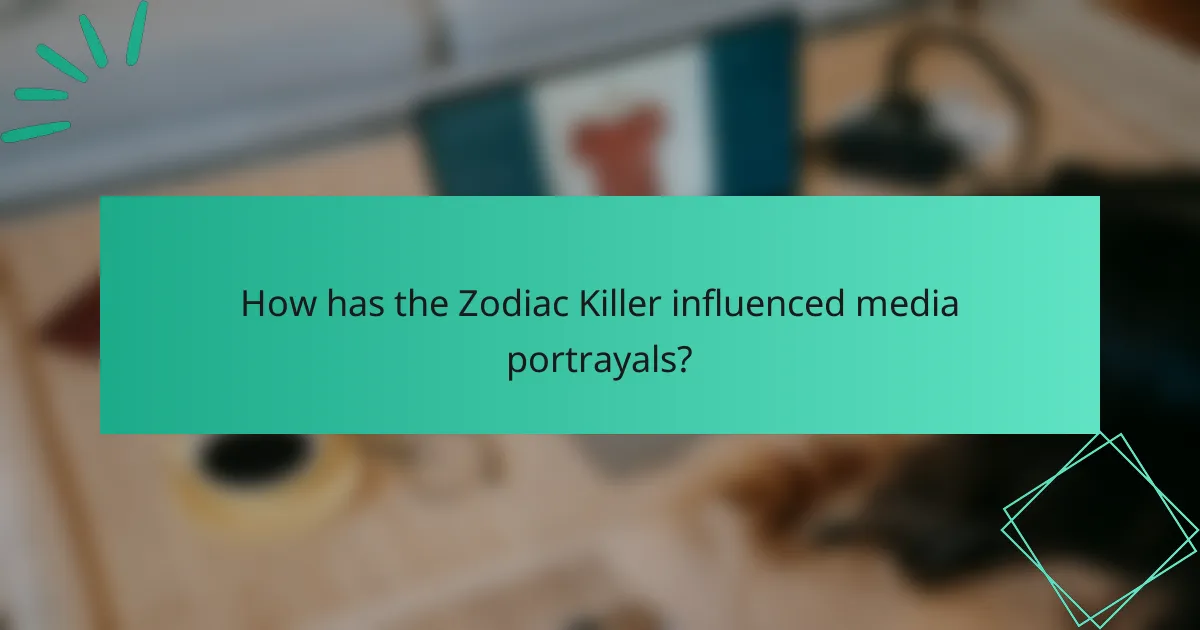
How has the Zodiac Killer influenced media portrayals?
The Zodiac Killer has significantly shaped media portrayals of serial killers, creating a lasting impact on public fascination and fear. This influence is evident in various documentaries, crime dramas, and news coverage that have both informed and sensationalized the narrative surrounding the case.
Documentaries like ‘The Zodiac’ and their impact
Documentaries such as ‘The Zodiac’ have played a crucial role in shaping public understanding of the Zodiac Killer. They often blend factual reporting with dramatic reenactments, which can enhance viewer engagement but may also blur the lines between reality and fiction.
These films typically explore the psychological aspects of the killer, the investigative challenges, and the societal reactions, contributing to a more complex portrayal of the events. The impact is significant, as they can influence how audiences perceive not only the Zodiac case but also the nature of crime itself.
Influence on crime dramas such as ‘Mindhunter’
Crime dramas like ‘Mindhunter’ have drawn inspiration from the Zodiac Killer, reflecting a broader trend in television to explore real-life criminal psychology. These shows often depict law enforcement’s efforts to understand and capture serial killers, emphasizing the interplay between criminal behavior and societal response.
By dramatizing these narratives, such series can create a heightened sense of intrigue and fear, often leading viewers to develop a fascination with the criminal mind. This portrayal can shape public perception, making serial killers appear more enigmatic and their crimes more sensational.
Role of news coverage in shaping public perception
News coverage of the Zodiac Killer has profoundly influenced public perception, often sensationalizing the events to attract viewership. Headlines and reports frequently emphasize the mystery and horror surrounding the case, which can lead to increased public fear and fascination.
Moreover, the way news outlets report on such cases can create lasting stereotypes about serial killers, often portraying them as more dangerous and elusive than they may be in reality. This can skew public understanding and response to crime, reinforcing myths rather than providing a clear picture of criminal behavior.

What is the public perception of the Zodiac Killer today?
The public perception of the Zodiac Killer today is a mix of intrigue and horror, fueled by ongoing discussions about the unsolved nature of the case. Many view the Zodiac as a symbol of the dark side of human psychology, while others are captivated by the mystery surrounding his identity and motives.
Public fascination with unsolved cases
Unsolved cases like that of the Zodiac Killer continue to captivate the public due to their inherent mystery and the psychological complexity involved. This fascination often stems from a desire to understand the unknown and the fear that such individuals could still be at large. Documentaries, podcasts, and books frequently explore these cases, keeping them alive in the public consciousness.
Moreover, the Zodiac Killer’s case is particularly compelling because of the cryptic letters he sent to the media, which added an interactive element to the mystery. This engagement encourages amateur sleuths and true crime enthusiasts to delve deeper into the case, often leading to new theories and discussions.
Impact of social media on perceptions
Social media has significantly influenced perceptions of the Zodiac Killer by providing platforms for discussion and the sharing of theories. Online forums and social networks allow users to connect, share insights, and debate various aspects of the case, often leading to viral trends surrounding new findings or theories.
Additionally, social media can amplify misinformation, as sensationalized posts may distort facts or promote unfounded theories. This can create a skewed perception of the case, where the line between fact and fiction becomes blurred, making it essential for individuals to critically evaluate the sources of information they encounter.

How have films and books shaped the Zodiac Killer narrative?
Films and books have significantly influenced the public perception of the Zodiac Killer, often blending fact with fiction. These media portrayals have shaped narratives, created myths, and impacted how the case is understood and discussed.
Key films like ‘Zodiac’ and their reception
The film ‘Zodiac’, directed by David Fincher, was released in 2007 and received critical acclaim for its meticulous attention to detail and atmospheric storytelling. It portrays the investigation into the Zodiac Killer, focusing on the obsession of journalists and police, which resonated with audiences and reignited interest in the case.
Viewer reception was largely positive, with many praising its realistic depiction of the era and the psychological toll of the investigation. The film’s success helped to solidify the Zodiac Killer as a cultural icon, influencing other media and public discussions about unsolved crimes.
Influential books such as ‘Zodiac Unmasked’
‘Zodiac Unmasked’ by Robert Graysmith is a pivotal book that delves into the identity of the Zodiac Killer, offering theories and evidence that have captivated readers. This book, along with others, has contributed to the ongoing fascination with the case, blending investigative journalism with narrative storytelling.
Such books often provide detailed analyses of the killer’s letters and cryptograms, encouraging readers to engage with the mystery actively. They have sparked debates and discussions, influencing both amateur sleuths and seasoned investigators in their pursuit of the truth.
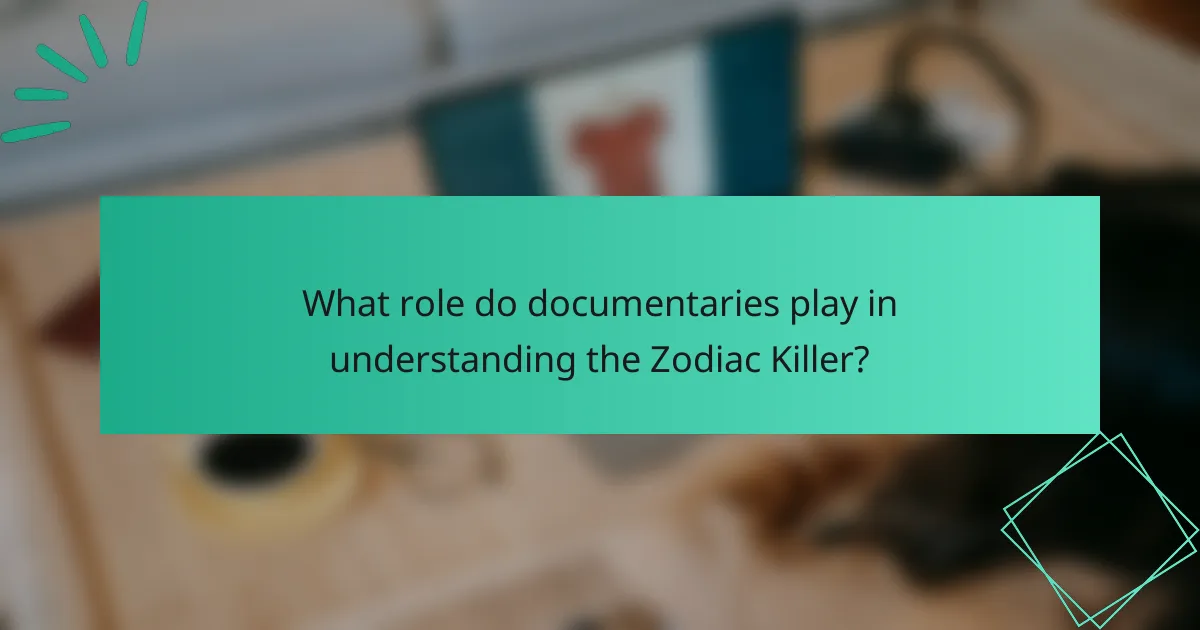
What role do documentaries play in understanding the Zodiac Killer?
Documentaries about the Zodiac Killer serve as vital tools for educating the public about the case, its historical context, and ongoing investigations. They often blend factual storytelling with expert analysis, helping viewers grasp the complexities of this infamous unsolved mystery.
Critical analysis of ‘The Zodiac Killer’ documentary
‘The Zodiac Killer’ documentary has been noted for its in-depth exploration of the case, featuring interviews with law enforcement officials and experts. It critically examines the evidence and theories surrounding the killer’s identity, offering viewers a comprehensive perspective on the investigation.
However, some critiques highlight that the documentary may sensationalize certain aspects, potentially skewing public perception. Viewers should approach the content with a critical mindset, distinguishing between entertainment and factual reporting.
Viewer engagement and its effects on awareness
Viewer engagement with documentaries can significantly enhance public awareness of the Zodiac Killer case. As audiences discuss and share their thoughts online, they contribute to a broader dialogue about unsolved crimes and the importance of cold case investigations.
This engagement can lead to increased interest in forensic science and law enforcement practices, encouraging viewers to advocate for resources dedicated to solving such cases. However, it is essential for viewers to seek out credible sources and avoid misinformation that can arise from sensationalized portrayals.
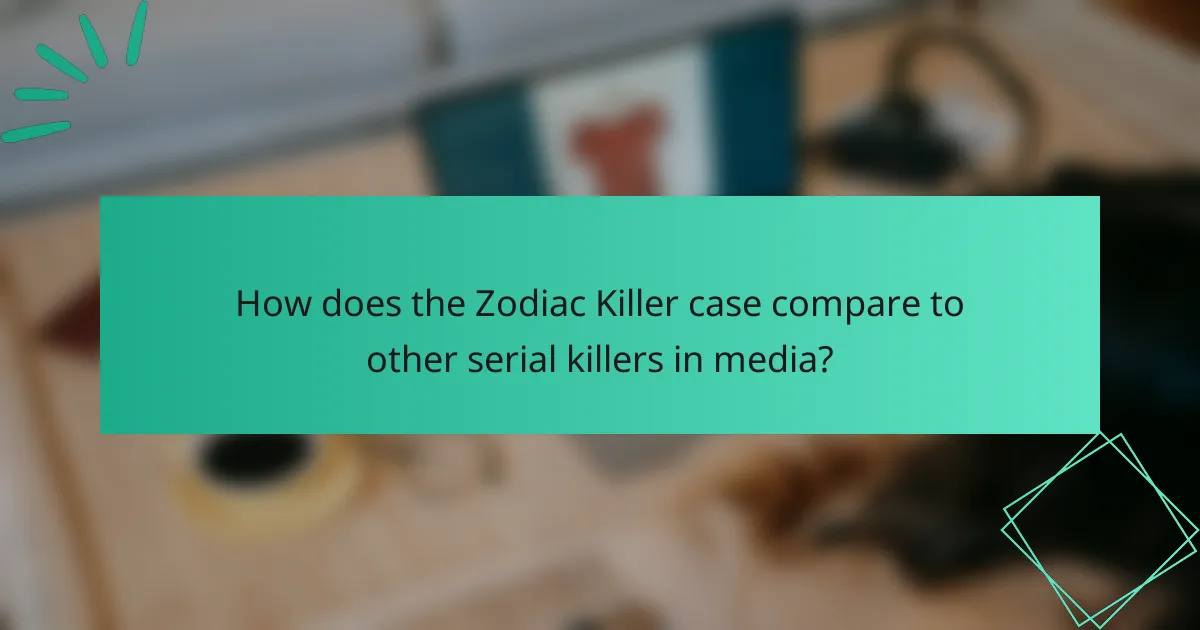
How does the Zodiac Killer case compare to other serial killers in media?
The Zodiac Killer case stands out in media portrayal due to its blend of mystery, taunting letters, and public fascination. Unlike many serial killers, the Zodiac’s unsolved nature and cryptic communications have led to extensive media coverage and a lasting cultural impact.
Comparative analysis with Ted Bundy coverage
Media coverage of Ted Bundy focused heavily on his charm and intelligence, often portraying him as a charismatic figure despite his horrific crimes. In contrast, the Zodiac Killer’s anonymity and cryptic messages created a different narrative, emphasizing fear and intrigue over personal charisma.
While Bundy’s trials were televised and widely reported, the Zodiac Killer’s story unfolded through letters and ciphers, which captivated the public’s imagination. This difference in media approach shaped how each case was perceived, with Bundy often depicted as a monster hiding in plain sight, while the Zodiac remained an elusive figure shrouded in mystery.
Media strategies for different serial killer cases
Media strategies vary significantly based on the nature of the serial killer’s crimes and their public persona. For instance, sensationalism often accompanies cases like Bundy’s, where the killer’s background and trial become focal points for storytelling.
In the case of the Zodiac Killer, media outlets employed investigative journalism techniques, focusing on the puzzles he left behind. This strategy not only engaged the audience but also encouraged public participation in solving the mystery, which is less common in other serial killer narratives.
Ultimately, understanding these media strategies can help in analyzing public perception and the cultural impact of different serial killers. Each case’s unique elements dictate how the media shapes the narrative and influences public interest.

What are the ethical considerations in media portrayals of the Zodiac Killer?
Media portrayals of the Zodiac Killer raise significant ethical concerns, particularly regarding sensationalism and the impact on victims’ families. Responsible reporting should prioritize factual accuracy while being sensitive to the emotional toll on those affected by the crimes.
Balancing sensationalism with factual reporting
Media outlets often face the challenge of attracting viewers while maintaining journalistic integrity. Sensationalism can lead to exaggerated narratives that distort the truth, making it essential for journalists to focus on factual reporting. Striking a balance involves presenting the story in a compelling way without compromising accuracy or respect for the victims.
For instance, while graphic details may draw attention, they can also desensitize the audience and overshadow the real human suffering involved. Ethical reporting should aim to inform the public while avoiding unnecessary dramatization.
Impact on victims’ families and communities
The portrayal of the Zodiac Killer in media can have profound effects on the families of victims and the surrounding communities. Sensational coverage may reopen old wounds, causing distress and trauma for those who have suffered loss. It is crucial for media to consider the emotional ramifications of their stories and to approach the subject with empathy.
Communities affected by such crimes often grapple with fear and stigma, which can be exacerbated by sensationalized narratives. Media should strive to highlight the resilience and healing of these communities rather than perpetuating fear or stereotypes.

How has public interest in the Zodiac Killer evolved over time?
Public interest in the Zodiac Killer has fluctuated significantly since the late 1960s, driven by media coverage, new evidence, and popular culture. Initially a local phenomenon, the case has grown into a national obsession, with renewed attention during key anniversaries and developments.
Trends in media coverage since the 1960s
Media coverage of the Zodiac Killer began intensely in the late 1960s, with newspapers publishing letters from the killer and sensationalizing the murders. This coverage played a crucial role in shaping public perception, turning the case into a national story. Over the decades, documentaries, books, and films have further fueled interest, often blending fact with fiction.
In recent years, the rise of social media has transformed how information about the Zodiac Killer is shared. Online forums and platforms allow enthusiasts to discuss theories and share discoveries, creating a community that keeps the case alive in public discourse. This has led to a resurgence of interest, particularly among younger generations who engage with the mystery through digital storytelling.
Shifts in public interest with new evidence
Public interest in the Zodiac Killer has seen spikes with the emergence of new evidence or investigative breakthroughs. For instance, advancements in forensic technology, such as DNA analysis, have led to renewed hope of identifying the killer, reigniting media coverage and public fascination. Each new lead or theory often results in a flurry of discussions and renewed investigations.
High-profile documentaries and podcasts have also played a significant role in shifting public interest. These platforms often present fresh perspectives on the case, encouraging audiences to reconsider previously accepted narratives. As new theories gain traction, they can lead to increased scrutiny of the original investigations and the media’s portrayal of the events.

What emerging trends are influencing the Zodiac Killer narrative?
Emerging trends such as advancements in digital forensics and the rise of social media are significantly reshaping the Zodiac Killer narrative. These developments enable both law enforcement and the public to engage with the case in new ways, fostering renewed interest and speculation.
Impact of digital forensics on case re-examination
Digital forensics has revolutionized how cold cases like the Zodiac Killer are analyzed. Techniques such as DNA analysis and data recovery from old evidence can provide new leads and insights that were previously unattainable.
For instance, law enforcement agencies are now able to re-examine physical evidence using modern DNA testing methods, which can yield results from samples that were once deemed unusable. This has led to breakthroughs in several cold cases, suggesting that similar approaches could be applied to the Zodiac Killer investigation.
Moreover, the integration of digital databases allows for better cross-referencing of evidence with other unsolved cases. This can help identify patterns or links that may not have been apparent before, potentially leading to new suspects or theories about the Zodiac Killer’s identity.
